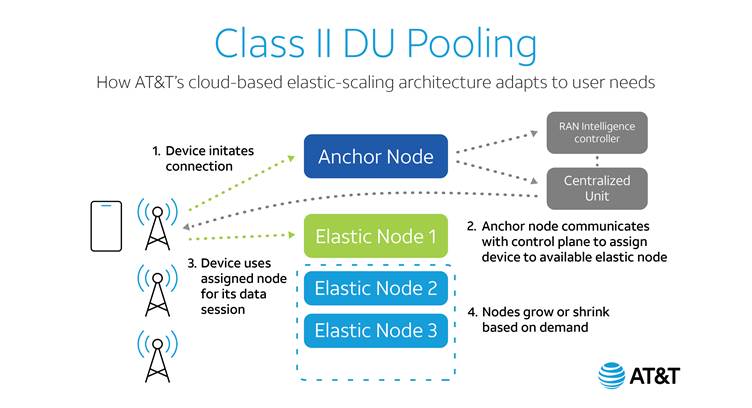AT&T and Intel co-develop industry-leading advanced RAN pooling technology freeing 5G radios from the limitations of dedicated base stations, while enabling more efficient, resilient, and green 5G networks.
In today’s data-driven communications world, it’s hardly possible to go even a few hours without mentioning the word “cloud.”
So, what is the cloud’s (not so) secret superpower that has allowed it to grow to such a prominent place in our lives in a few short years? One leading answer is elastic scaling – the ability to use only as much computing hardware as you need at any time, flexibly growing or shrinking the servers needed for complex tasks as demand changes.
Elastic scaling allows the Internet services we know and love to remain efficient and eco-friendly. By vacating unneeded servers constantly, servers that usually consume a lot of power can now be recycled for other tasks and put to sleep to save energy – all while substantially reducing the number of servers and equipment needed.
What’s more, elastic “active-active” scale-out architectures also provide a more reliable service. Because we are essentially requiring software to be written in a way that it isn’t strongly tied to a particular piece of hardware, when one piece of equipment fails, another can instantly take over its tasks.
Because of all its benefits to our planet, our customers and our shareholders, operators like AT&T have been racing to elasticize their 5G networks. At AT&T we’ve been transitioning our mobility core network to a virtualized version since 2014. As of 2020, we’ve virtualized more than 75% of our network functions . That is, everywhere except the Radio Access Network, or the RAN.
Achieving elasticity in the RAN brings a completely different set of challenges to resolve. The RAN base station distributed units (DUs) are one of the most distributed, resource intensive, and complicated parts of a wireless network. It’s where that video conference with your coworkers or those vacation photos that you’re downloading are transformed from data packets into the radio waveforms that are transmitted and received by the radios at the top of cell towers.
DUs have to coordinate with radios in microseconds. In comparison, most Internet services operate at timescales of milliseconds or over a thousand times slower. DUs have to extract meaningful signals from noisy waveforms with all kinds of signal interference, and they are responsible for making sure that radio spectrum, a valuable and limited natural resource worth billions, is shared fairly and efficiently across all the other users in the neighborhood.
Due to these hyper-stringent requirements, radios have traditionally needed to be physically connected to baseband equipment dedicated to the radio and ready to go at a microsecond’s notice even if it’s the middle of the night and nobody is using the radio. And so, the mapping between radios and servers was not very elastic. At least until now.






















